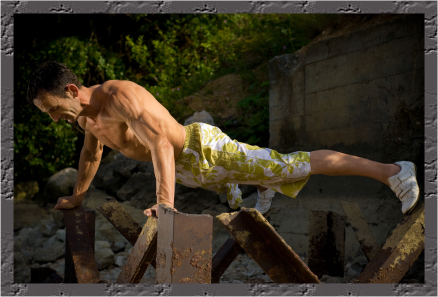FIVE Quick Ways to Leave Fitness Plateaus Behind

You’ve set your SMART Fitness Goal and set off on your fitness journey exuding confidence and determined to succeed. You’ve started eating healthier, hitting weights at the gym 4 times a week, and are actually starting to see some decent results. Then suddenly, and rather unexpectedly, your results just STOP.
You feel like you’re doing everything right, but for some reason it appears that you’ve hit some sort of fitness glass ceiling. Week after week brings lackluster results, if any at all, and slowly the fitness fire that once burned insanely bright stoked by the results you experienced early on in your journey starts fading. Working out is steadily becoming just a little more boring, and without any new results to show for it, what’s the point? You’re doing everything right, and yet the fruits of your labor are so meager that they leave you starving for results.
Many a dream of building lean muscle, losing fat, and getting in fabulous shape has been derailed by two simple words that we use all the time in fitness circles.
Habit & Routine.
Something is routine when it’s something that is regular and unvarying. Making something a routine is often the first step in developing the habits required to accomplish a task or goal. A habit is a pattern of behavior that a person follows until it becomes almost involuntary. Of course habits can be good or bad, but can they also be both?
The good side of a developing a fitness-focused habit like strength training is that it gets you in the door and at least doing something. The bad side or danger of making your workouts a habit is that you run the risk of falling into a rut of doing the same few workout variations day after day.
Doing the same workout too frequently can result in overtraining, which means that you’re not allowing your muscles adequate recovery time based on the frequency and intensity of your workouts. Overtraining can limit your strength gains, and actually cause you to lose strength.
Without the variety that comes from exploring the full menu of options presented to you in your fitness journey, your journey can start to feel like nothing more than a laborious punishment. As your strength increases your body starts to get used to the original demands you’ve place on it, and as a result it does not respond as dramatically to the same routine as it once did. What does this mean?
Spicing up your workouts with a little variation is all that’s needed to leave your fitness plateaus behind, and take your fitness journey to the next level.
I’m a HUGE believer that strength training should be a part of everyone’s fitness journey. No matter what your current attack plan (not “routine” :)) is when you enter a gym, consider the five variables mentioned below and whether or not you take advantage of all five.
The FIVE variables that you can change in your strength training to help you reach new levels and reinvigorate your passion are:
- Reps
- Sets
- Tempo
- Trainer
- Weight
Reps (repetition) – A rep consists of three phases.
- The first phase, typically called the concentric phase, consists of lifting the weight via muscle contraction.
- The second phase, called the isometric phase, is the transition or peak contraction phase that is reached at the midpoint of the lift when the muscle is fully contracted.
- The third and final phase called the eccentric phase consists of returning to the starting position as the muscle relaxes.
Varying the amount of reps you perform in an exercise will effect other variables like sets and weight. A recent Fit Desk Jockey article titled “How Many Reps and Sets Should I Do“ examines the low rep/heavy weight and high rep/light weight argument in greater detail. Several recent studies mentioned in the article have indicated that working a muscle to muscle failure is the single requirement needed for building muscle size and strength, regardless of the weight used or number of sets performed.
A common practice is to approach an exercise with the thought “I’m going to do 3 sets of 8 dumbbell curls”. The problem with this is type of approach that it results in you stopping your body instead of letting your body stop you, which virtually eliminates any chance you have of working yourself to muscle failure. Instead, once you’ve hit your target number of reps keep going and see if you can do 9, 1o, 11, etc. Remember that real gains come from those last few reps.
If you’ve always done 3 sets of 8 reps for your exercises and your not seeing results like you once did, change it up. Reduce the amount of weight you’re using slightly and try doing 3 sets of 15 reps, or increase the amount of weight you’re using a try doing 4 sets of 5 reps.
Sets – A set is many reps preformed one after another without any rest between. Generally there is an inverse relationship between the number of reps and the number of sets in an exercise. A set could consist of performing a certain number of reps that has been established as a goal, or may consist of performing as many reps as possible with a certain time limit.
Despite the chatter polluting gyms and fitness circles everywhere, I’ve not found a single study that indicates that lifting light weights for more reps results in “toning”. What I’ve experienced firsthand is that doing lighter weights for more reps increases muscular endurance, meaning how long your muscles can perform before reaching failure. Toning is ultimately accomplished by building your muscle mass and decreasing your body fat percentage.
When I first started I, like most people, always did three sets of every exercise without any variation. When I started lifting heavier for exercises like deadlifts and squats, I noticed that I achieved the much more dramatic results by approaching such lifts with a 5 x 5 type mentality. In a 5 x 5 lift you chose a weight that allows you to do perform roughly 5 reps per set and then do 5 sets.
If you’re not seeing the results you want, mix up your current workout by adding a fourth set, or by throwing in a few 5 x 5 sets. Keeping your body guessing will help keep it growing.
Tempo – The tempo a.k.a. cadence of an exercise refers to the amount of seconds spent in each of the 3 phases described above that make up “a rep”, which is often notated as s-s-s where “s” is the number of seconds.
Suzanne from WorkoutNirvana.com, a fellow fitness fanatic, ultra cool heavy weight lifter, and a killer blogger to boot, explains this concept perfectly in her post “Another Way to Grow Your Muscles: TUT” TUT stands for Time Under Tension, and refers to the amount of time your muscles are working in each rep/set. The National Academy of Sports Medicine states that the optimal time for hypertrophy (muscle growth) is 20 to 70 seconds per set, which means that for an 8 to 10 rep set you’d want your tempo to be between 4/2/1 and 2/0/2. For example, a 4/2/1 tempo for a bench press would mean that you’d want to lower the weight for 4 seconds, pause for 2 seconds, and then press it up rather quickly for 1 second.
Countless people you see working out perform reps with a very generic cadence of about one second up and one second down. There are multiple problems with this type of tempo including that it makes it tempting to use momentum to lift the weight, and that it places your muscles under tension for a relatively limited amount of time. Each of these reasons alone has the potential to reduce the quality of your workout. Performing reps at such a fast pace can also lead you to doing exercises with improper form, which can lead to the one thing that stops even the most committed fitness fanatic. Injury. Slow down and really focus on performing each rep in a focused and consistent manner.
Varying the tempo is an excellent way to kick the intensity of your workouts up a notch!
Trainer – A trainer can be an incredible asset for a number of reasons. I have no doubt that the time that I’ve spent with the trainers has been instrumental in the success I’ve experienced throughout my fitness journey.
Personal Trainers can:
- Help to tailor your workouts specifically to help you achieve your personal fitness goals
- Act as a second set of eyes to help ensure that you’re performing all your lifts with correct form, which helps to prevent injury and helps to ensure results.
- Be your spotter. For many of the most common lifts a spotter is a great way to ensure that you’re effectively and safety reaching muscle failure in your exercises. Many a nose has been broken by a fatigued lifter who was nearly 100% sure that they had the bar back up on the supports after their final bench press rep.
- Introduce you to new workouts that you can then incorporate into your workout rotation to help keep you from getting into a rut and plateauing.
- Help you learn and incorporate new exercises and methods of training to spice up your workouts and make them fun and challenging again.
- Push you to levels beyond what you would do for yourself. Most people, myself included, will be surprised by how much intensity their body can actually handle. Trainers are great for showing you just how far you can safely take your workouts.
So is a trainer required to get in better shape? Of course not, but it does make sense for a lot of people.
Weight – The amount of weight that you start at various lifts should be based on your 1RM that you set the first day you set off on your fitness journey. For high intensity training, it is generally recommended that you use a weight that is 70% to 85% of your one rep max. The goal is to train with the heaviest weight possible that still allows you to perform the number of reps desired.
For example, when I’m in my heavy stage I’m picking weights that will allow me to do the number of reps I’ve set as a goal (6 to 8 reps). If I can do more than the top number for all sets, then I draw a little up arrow next to the weight I used and circle it, which reminds me to go heavier the next time I do that particular lift.
Generally speaking their is an inverse relationship between the number of reps you intend in performing and the amount of weight you’ll use. If you’ve always lifted heavy weights, and are not happy with your progress, you may want to try to dropping the weight a few levels and doubling the reps, or vice versa if you typically lift lighter weights at higher reps.
Bonus: Education – If your own fitness is important to you, then you really owe it to yourself to never stop learning about new ways to be efficient and effective in your fitness pursuit. Reading what others are doing, and/or taking to friends, coaches, and trainers, is a wonderful way to find your next favorite workout. Consider the information a collection of priceless experienced-based maps provided enthusiastically by people who’ve traveled journeys very similar to your own and found improvement, contentment, and their own version of fitness bliss. Learning from the experiences of others and testing them in your own workouts is a great way to find out what works for you, and make their methods your own.
To sum it all up, I’d say that the keys to escaping plateaus is variation. Fear not if you wake up one day at the gym and find yourself standing deep in a rut. Climb out. Reclaim and recover.
Do you have any secrets that you employ to keep your exercise attack plans exciting and challenging? Until next time, I am Matt and I want to sincerelly thank you for being a part of the Fit Desk Jockey Family.
Family, Fitness, and Fun!
-Matt





Thanks for the shout out Matt! This is your best article to date (and it’d be hard to choose) – totally worth saving, sharing, and printing. The science is essential but love your insider tips too! I agree so much with everything you say, especially the 5×5 mentality and benefits of trainer. My clients are always surprised by how hard I push them, but more importantly, that they could push that hard! Another thing you hit on (and which I’m passionate about) is the tempo… rushing reps might be the most common mistake I see in gym. Hey, slow down and enjoy yourself! 😉 Thanks for a great article Matt – you rawk!!
@WorkoutNirvana Thank you for visiting AND thanks for all the kind words. 🙂 It truly means a lot coming from you!
Brutal trainers are the BEST trainers in my book! I knew you were punishing people (in a good way of course :))
I’ve had multiple trainers push me harder than I thought I could take at first, and the effect was that it made every single one of my workouts better, even when I was just on my own.
I love the after-burn that happens when you slow down the tempo of your reps.
Best wishes!
-Matt